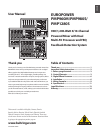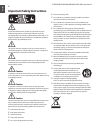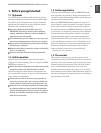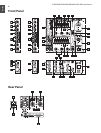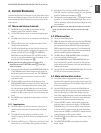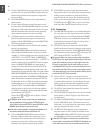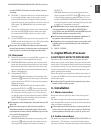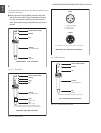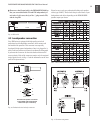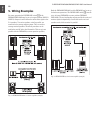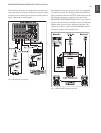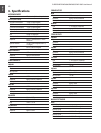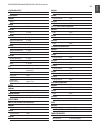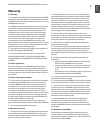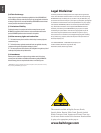
ENGLISH
EUROPOWER PMP960M/PMP980S/PMP1280S User Manual
6
Use this 5-digit LED meter to control the output level of the
[24]
monitor signal. The upper LIM LED illuminates when the
internal amp protection circuit responds to output levels
that are too high.
The MAIN MASTER control is used to adjust the main
[25]
output volume.
Use this 5-digit LED meter to control the output level of
[26]
the main signal. The PMP980S/PMP1280S has two rows of
LED meters (L/R), because the signal is stereo. The upper
LIM LED illuminates when the internal amp protection
circuit responds to output levels that are too high.
+48V phantom power is provided for condenser micro-
[27]
phones. The phantom power supply is activated for all
channels with the PHANTOM switch and the PHANTOM
LED above the switch illuminates.
Use the POWER AMP switch to determine the operating
[28]
mode of your power mixer.
The PMP980S/PMP1280S has three different operating
modes: In MAIN L/MAIN R mode it functions as a stereo
amplier, i.e. the left and right main stereo signals are sent
to OUTPUT A (L) and OUTPUT B (R). In MON/MONO
mode it functions as a dual mono amplier, i. e. OUTPUT A
sends the monitor signal, and OUTPUT B the main signal
(mono). In BRIDGE AMP MODE the output power of
outputs A and B are added and provided at OUTPUT B.
The PMP960M also has three operating modes, since it can
be operated in two modes with the switch in its upper position
(MAIN/MAIN (BRIDGE) mode), depending on the pin connec-
tions of the speaker cables. In MAIN/MAIN (BRIDGE) mode
power of both outputs is added and provided at OUTPUT B
(Locking cable, pins 1+/2+). With the normal pin connections
(Locking cable, pins 1+/1-) a main signal is provided in this
mode at OUTPUT A and B (not bridged). In MON/MAIN
mode, the mixer can also be used as a dual mono amplier,
i.e. OUTPUT A provides the monitor signal, while the main
signal is present at OUTPUT B.
Please refer to (44) and (45) as well as chapter 4.4 “Loud-
speaker connectors”.
In BRIDGE mode, always connect only one loudspeaker
◊
with an impedance of at least 8 Ω to OUTPUT B (pins
1+/2+)! Please note that OUTPUT A must NEVER be used in
BRIDGE mode (with pin connections 1+/2+)!
In all other operating modes, the minimum impedance of
◊
the speaker connected must not fall below 4 Ω.
Use the SPEAKER PROCESSING switch to activate a
[29]
lter that adapts the mixer to the specications of your
loudspeakers. If the speakers have a limited frequency
response in the bass range, it allows you to adapt it
optimally to the frequency response of the speakers.
If STANDBY is pressed, all input channels are muted.
[30]
During breaks you can thus prevent the microphones from
picking up noise or interference, which would then be
reproduced by the P.A. system. The advantage is that all
faders can be left untouched while you play a CD via the
CD/TAPE inputs (see (35)). There is also no need to move
down the faders of muted channels and lose your mix.
Connectors2.3.1
The FOOTSWITCH connector is for a standard footswitch.
[31]
You can activate an “effect bypass” that mutes the effects
processor. Please use a dual footswitch for the PMP980S/
PMP1280S, so that you can enable/disable FX1 and FX2
independently of each other. In this case, the tip of the ¼"
plug controls FX1, and the ring FX2.
The FX OUT connector is used to route the FX SEND
[32]
signal from the input channels, for example, to the input of
an external effects processor. The PMP980S/PMP1280S has
two FX controls per input signal (see {5}) and also two FX
OUT connectors (FX OUT 1 and FX OUT 2).
Please note: When you connect a mono plug to one of the
◊
FX OUT jacks, the signal path from the respective FX send
to the built-in effects processor is interrupted. For each
FX send you can either use the built-in effect or the cor-
responding FX OUT jack (for an external effect), but never
both at the same time. When you use a stereo plug (tip and
ring interconnected) you can use the built-in effects proces-
sor and the FX OUT jacks in parallel.
Use the AUX IN ¼" inputs to route an external stereo
[33]
signal to the main mix. This can be the signal generated by
an external effects processor. Use the left input for mono
signals, which are then reproduced on both stereo sides.
The PMP960M has only one mono AUX IN connector.
The AUX IN control adjusts the volume of the external
[34]
signal in the main mix.
The CD/TAPE IN RCA input allows you to feed in external
[35]
stereo signals, e.g. from a CD player, tape deck or other
line-level source.
The VOICE CANCELLER lters vocal-specic frequencies
[36]
from the CD/TAPE IN signal. This function can be used
for karaoke, i.e. you can remove the vocals from a song and
then sing along with the music yourself.
The REC OUT (RCA) provides line-level signals from
[37]
the power mixer to a DAT recorder, for example. On the
PMP980S/PMP1280S the REC OUT signal is stereo and on
the PMP960M two identical mono signals are provided.
If the REC OUT signal is connected to a recorder whose
◊
output signal is returned to the CD/TAPE IN, feedback can
occur when you activate the record function. So, discon-



